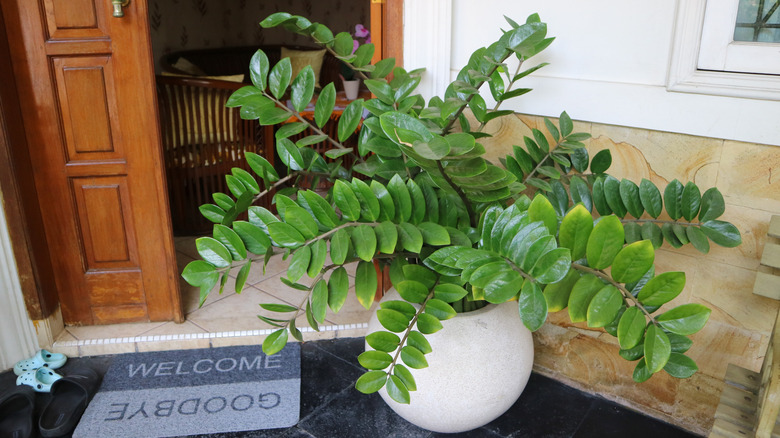Common Pests You Should Know About Before Jumping On The ZZ Plant Trend
We may receive a commission on purchases made from links.
While there is no shortage of easy plants for houseplant newbies, many have been charmed by the ZZ plant's (Zamioculcas zamiifolia) minimal maintenance needs. Because it's content in areas with just a bit of light, you can keep this shiny-leaved species in a dark corner of your living room, a home office with a tiny window, or another location where most other plants would perish. It only requires occasional watering, so it's unlikely to croak if you go on a trip and forget to ask a friend to water it. It's not even fussy about humidity like some tropical houseplants are. Its main weaknesses involve aphids, spider mites, and other pests. Inspect your ZZ plant regularly to spot pest problems before they proliferate. The earlier you treat an infestation, the more successful you will be.
If you notice signs of bugs, quarantine your ZZ plant so the invaders don't migrate to your other houseplants. Then, find the right kind of treatment for the pests in question. Neem oil is good at evicting spider mites, aphids, and other bugs that bother these plants. It can also treat certain fungal diseases. Make a DIY neem oil pest-control spray, then apply it to any part of the plant insects have been eating or inhabiting. If neem oil isn't available, make your own insecticidal soap to keep aphids and spider mites off your plants, or purchase a product such as Bonide Liquid Insecticidal Soap for houseplants. Use this soap just as you would use neem oil. Also, learn about the pests that prey on ZZ plants so you know what you might have to contend with in the future.
Identifying and evicting ZZ plant pests
Spider mites are drawn to ZZ plants, where they drink its sap and build tiny webs. As the infestation persists, leaves yellow, die, and drop from the plant. To find these miniature arachnids, look for webbing and red, yellow, or green dots on the plant's foliage. Try spraying water on your plant before applying neem oil or insecticidal soap. This can blast off some mites, making eradication easier. You can adopt a similar approach with two other sapsuckers: aphids and thrips. Aphids are soft-bodied insects, and thrips' long, brown bodies are hard to see because they're so small. Both may be found on leaves' undersides. Thrip problems typically show up as wrinkled leaves with brownish-yellow streaks. If thrips strike your plant, be sure to prune off damaged stems and leaves.
Also, look for scale insects, mealybugs, and fungus gnats on your ZZ plant. You might mistake scale insects for a plant disease since they look like little brown or gray lumps on leaves and stems. Two of the best ways to get rid of scale insects on plants are knocking them off with a soft cloth and spot-treating suspect lumps with rubbing alcohol. You can also use this rubbing alcohol treatment on white, fuzzy-looking mealybugs. Fungus gnat larvae live in the soil and feed on roots, which can make your ZZ plant frail. To get rid of larvae, dry out the soil in your plant's pot between watering and pour diluted hydrogen peroxide on the soil until it's sopping wet. You can catch grown-up gnats with a product like Cleanuper Flying Insect Traps.

